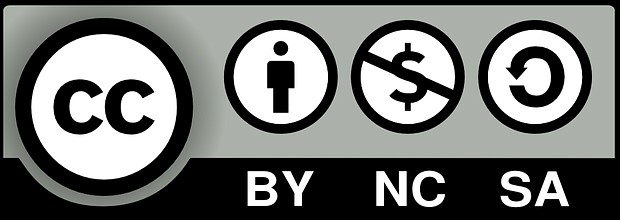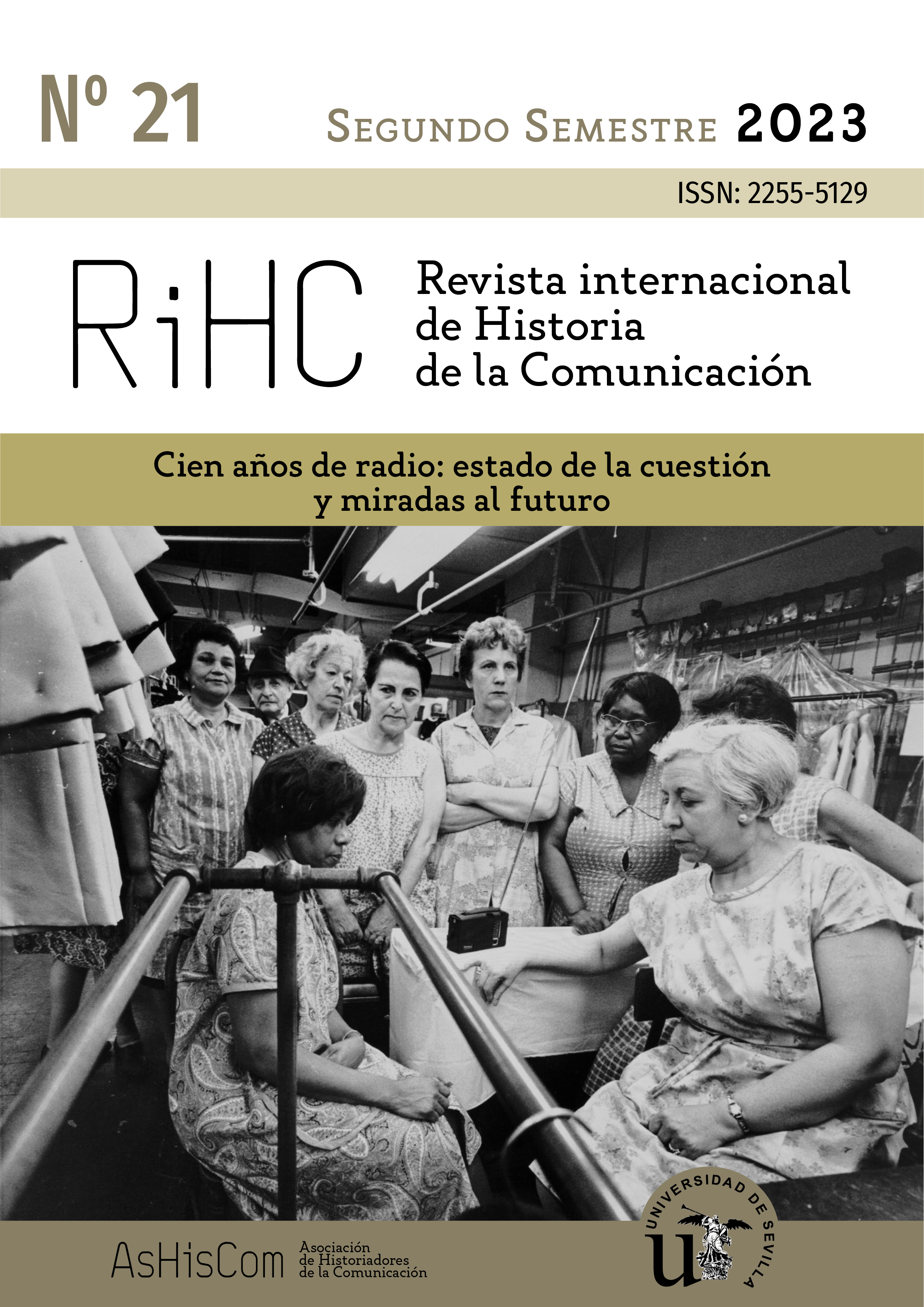Radio Luxembourg y Europe n°1 en la década de 1960: actores transnacionales e intermediales por antonomasia
DOI:
https://doi.org/10.12795/RIHC.2023.i21.05Palavras-chave:
Radio Luxembourg, Europe n°1, Historia transnacional, Intermedialidad, Radios comercialesResumo
Las emisoras de radio comerciales, como Radio Luxemburgo y Europe n°1, fueron medios de comunicación muy populares en la Europa Occidental de los años 60. Sin embargo, los investigadores no les han prestado tanta atención como a sus homólogas públicas. Siguiendo una tendencia que trata de volver a poner el foco sobre ellas, esta contribución revela el rico potencial que estas radios tienen para la literatura histórica y los radio studies. En este sentido, el trabajo constituye un alegato para profundizar en su análisis. Al tratarse de entidades comerciales, que no están obligadas a compartir sus archivos y que, a menudo, se encuentran en múltiples localizaciones y en diferentes idiomas, el proceso de investigación resulta, en ocasiones, dificultoso. A pesar de esto, escribir su historia ofrece muchas oportunidades. Así pues, y dado que estas emisoras tenían su sede en regiones periféricas de grandes mercados —en el caso francés, por ejemplo, para evitar el monopolio estatal—, se convierten en actores transnacionales clave. No obstante, no sólo son sujetos ideales para comprender la historia de la radio a través de las fronteras, sino que también son especialmente relevantes cuando se trata de estudios transmedia. En efecto, emisoras como Radio Luxemburgo y Europe n°1 dependían, en gran medida, de otros medios de comunicación para apoyar su aventura empresarial global. Por todo ello, esta contribución abordará su potencial para enriquecer la historia de la radio mediante la inclusión de perspectivas de análisis transnacionales e intermediales.
Downloads
Referências
ANNA, J. (2018): Welle der Konsumgesellschaft: Radio Luxembourg in Frankreich, 1945-1975, Göttingen, Wallstein.
ANTOINE, F. (2016): Analyser la radio. Méthodes et mises en pratique, Louvain-la-Neuve, De Boeck.
BADENOCH, A.; FICKERS, A. y HENRICH-FRANKE, C. (eds) (2013): Airy Curtains in the European Ether: Broadcasting and the Cold War, Baden-Baden, Nomos.
BECCARELLI, M. (2021): Micros de nuit. Histoire de la radio nocturne en France, 1954-2012, Rennes, Presses Universitaires de Rennes.
BERG, K. (2021): Grenzenlose Unterhaltung: Radio Luxemburg in der Bundesrepublik 1957-1980, Göttingen: Wallstein.
BERG, K. y JEHLE, A. (2916): “Through the Air to Anywhere: Radio Luxembourg - A Transnational Broadcasting Station?”, en Classen, C. (editor), Transnational Broadcasting in Europe 1945-1990, Frankfurt am Main, Peter Lang, pp. 23-44.
BLANDIN, C. (ed.) (2018): Manuel d’analyse de la presse magazine, Malakoff, Armand Colin.
BULL, M. (2004): “Sound, Proximity, and Distance in Western Experience”, en Erlmann, V. (editor), Hearing Cultures. Essays on Sound, Listening and Modernity, Oxford, Berg, pp. 173-190.
CHION, M. (2012): “100 concepts pour penser et décrire le cinéma sonore”, disponible en http://michelchion.com/texts [recuperado el 20 de agosto de 2023].
COHEN, D. R.; COYLE, M y LEWTY, J. (eds.) (2009): Broadcasting Modernism, Gainesville, University Press of Florida.
CRISELL, A. (1994): Understanding Radio, London, Routledge.
CRONQVIST, M. y HILGERT. C (2017): “Entangled Media Histories. The Value of Transnational and Transmedial Approaches in Media Historiography” en Media History, 23:1, pp. 130-141.
CROOK, T. (2012): The Sound Handbook, Abingdon, Routledge.
DAKHLIA, J. (2018): “Propriétés et fonctions de la presse magazine”, en Blandin, C. (editor), Manuel d’analyse de la presse magazine, Malakoff, Armand Colin, pp. 51-65.
FICKERS, A. (2009): “Radio” en AKIRA, I. y SAUNIERS, J. (editors), Palgrave Dictionary of Transnational History, Basingtoke: Palgrave Macmillan, pp. 870-873.
FÖLLMER, G. y BADENOCH, A. (eds.) (2018): Transnationalizing Radio Research: New approaches to an old medium, Bielefeld, Transcript.
GAUDREAULT, A. (1999): Du littéraire au filmique: Système du récit, Malakoff, Armand Colin.
GOODALE, G. (2011): Sonic Persuasion: Reading Sound in the Recorded Age, Urbana, University of Illinois Press.
HILMES, M. (2012): “Radio and the imagined community”, en STERNE, J. (editor), The Sound Studies Reader, Abingdon-on-Thames, Routledge, pp. 351-362.
IRIYE, A. y SAUNIER, J. (eds.) (2009): Palgrave Dictionary of Transnational History, Basingtoke, Palgrave Macmillan.
JENSEN, K.B. (2016): “Intermediality”, en Jensen, K. B. et al (eds.), The International Encyclopedia of Communication Theory and Philosophy, Chichester, John Wiley & Sons, pp. 972-982.
LACEY, K. (2018): “Up in the air? The matter of radio studies” en The Radio Journal: International Studies in Broadcast & Audio Media, 16:2, pp. 109-126.
LEGAY, R. (2020): Commercial Radio Stations and their Dispositif. Transnational and Intermedial Perspectives on Radio Luxembourg and Europe n°1 in the Long Sixties, Tesis Doctoral, University of Luxembourg.
- (2023): “‘Studying 1960s commercial radio”, en McDonald, K. y Chingell, H. (eds.), Bloomsbury Handbook of Radio, Londres, Bloomsbury, pp. 367-382.
LORIOU, C. (2018): “Faire de l’histoire, un casque sur les oreilles: le goût de l’archive radiophonique”, en Clavert, F. y Muller, C. (editors), Le Goût de l’archive à l’ère numérique, disponible en https://gout-numerique.net/ [recuperado el 20 de agosto de 2023].
MARTINEZ ALFARO, M. J. (1996): “Intertextuality: Origins and Developments of the Concept”, en Atlantis, 18:1-2, pp. 268-285.
MCDONALD, K. (2023): “The Radio Phone-in and the Suicide Caller”, en McDonald, K. y Chignell, H. (editors), Bloomsbury Handbook of Radio, Londres, Bloomsbury, pp. 190-207.
MÜLLER, J. E. (2000): “L’intermédialité, une nouvelle approche interdisciplinaire: perspectives théoriques et pratiques à l’exemple de la vision de la television”, en Cinémas, 10:2-3, pp. 105-134.
MURPHY, K. (2016): Behind the Wireless: A History of Early Women at the BBC, Londres, Palgrave Macmillan.
NICHOLAS, S. (2012): “Media History or Media Histories? Re-addressing the history of mass-media in inter-war Britain”, en Media History, 18:3-4, pp. 379-394.
OTA, N. (2019): “The Voiceful Voiceless: Rethinking the Inclusion of the Public Voice in Radio Interview Programs in Occupied Japan”, en Historical Journal of Film, Radio and Television, 39:3, pp. 584-601.
PÉREZ MARTÍNEZ, J. E. (2020): Radio y mujer (España, 1960-1975): En las Ondas de Radio Nacional, Madrid, Abada Editores.
RAJEWSKI, I. (2005): “Intermediality, Intertextuality, and Remediation: A Literary Perspective on Intermediality”, en Intermédialités/Intermediality, 6 (2005): 43-64.
RIKITIANSKAIA, M. (2018): “A Transnational Approach to Radio Amateurism in the 1910s”, en Föllmer, G. y Badenoch, A. (editores), Transnationalizing Radio Research: New Approaches to an Old Medium, Bielefeld, Transcript, pp. 133-140.
VAN REMOORTEL, M.; EWINS, K.; KOFFEMAN. M. y PHILPOTTS, M. (2016): “Joining Forces: European Periodical Studies as a New Research Field”, en Journal of European Periodical Studies, 1, pp. 1-3.
Downloads
Publicado
Como Citar
Edição
Secção
Licença
Direitos de Autor (c) 2023 Revista internacional de História da Comunicação

Este trabalho encontra-se publicado com a Licença Internacional Creative Commons Atribuição-NãoComercial-CompartilhaIgual 4.0.
RiHC. Revista internacional de Historia de la Comunicación es una publicación de acceso libre, ofrece su contenido bajo el principio de que hacer disponible gratuitamente la investigación al publico apoya a un mayor intercambio de conocimiento global.
RIHC. Revista internacional de Historia de la Comunicación se adhiere a las diferentes iniciativas que promueven el acceso libre al conocimiento, por lo que todos los contenidos son de acceso libre y gratuito y se publican bajo licencia de Creative Commons Reconocimiento-NoComercial 4.0 Internacional.

En virtud de ello, los autores que publiquen en esta revista aceptan las siguientes condiciones:
Los autores conservan los derechos de autor y ceden a la revista el derecho de la primera publicación, con el trabajo registrado con la licencia de atribución de Creative Commons, que permite a terceros utilizar lo publicado siempre que mencionen la autoría del trabajo y a la primera publicación en esta revista.
Los autores pueden realizar otros acuerdos contractuales independientes y adicionales para la distribución no exclusiva de la versión del artículo publicado en esta revista (p. ej., incluirlo en un repositorio institucional o publicarlo en un libro) siempre que indiquen claramente que el trabajo se publicó por primera vez en esta revista.
Se permite y recomienda a los autores publicar su trabajo en Internet (por ejemplo en páginas institucionales o personales) ya que puede conducir a intercambios productivos y a una mayor y más rápida difusión del trabajo publicado (vea The Effect of Open Access).
No prevé moving wall o período de embargo
Debe utilizarse la versión de editor/PDF
La fuente editorial debe reconocerse













